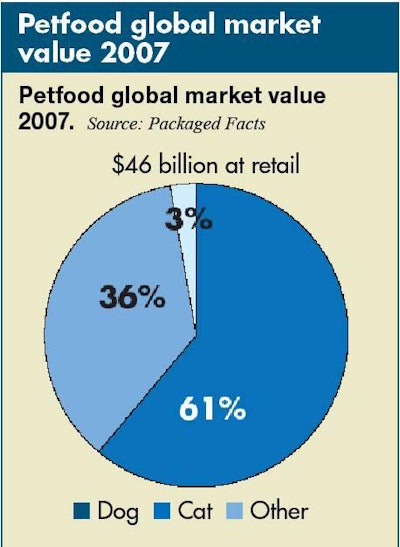
Market researcher David Lummis of Packaged Facts asserts that there are three primary trends driving growth in the global petfood market: humanization, convenience and health.
A report from Euromonitor predicts petfood's future, based on the top global trends from the present to 2012.
1. Upscale private label. Private label petfood products are encroaching upon premium and mid-priced segments in developed markets. Petfood superstores are particularly well placed to exploit this trend. In the developed world, this may be facilitated by the shadow cast over branded products by the recalls, as well as growing economic insecurity.
2. Origin and traceability. Now in the forefront, due to the recalls, are issues such as the quality and tractability of ingredients. Many consumers now suspect that branded petfood products are not markedly superior to their private label counterparts. The key to restoring or maintaining consumer faith in the branded segment will lie in successfully communicating product quality to consumers.
3. Economy products thrive. In developing economies, the premium segment accounts for a much smaller proportion of total petfood sales than in developed economies. Much of the growth that will be experienced over the 2007-2012 period is likely to come from the economy segment, as increasing numbers of people are lifted out of poverty in markets such as Brazil and China and chain retailers expand and deepen their distribution to reach these consumers.
4. Premium opportunities. As a result of the limited affordability of premium products in developing markets, the ability of petfood producers to increase sales volumes will be limited. While there will be some potential for premium products in locations with concentrations of affluent consumers, including Moscow, Beijing, Shanghai, Mexico City and Rio de Janeiro, these will be niche, rather than mass, markets.
5. Freshness advantage. One strategy that indigenous firms in developing markets can use to gain an advantage over foreign rivals at the very top end of the premium segment is to market their products in terms of their freshness, rather than in terms to market their products in terms of their freshness, rather than in terms of the quality and functional properties of their ingredients. In order to counter this, foreign players will have to either invest in local production facilitates through either joint ventures or acquisitions or utilize the kind of innovative packaging solutions (vacuum packing, refrigeration, etc.).
.png?auto=format%2Ccompress&fit=crop&h=167&q=70&w=250)

.png?auto=format%2Ccompress&fit=crop&h=167&q=70&w=250)











